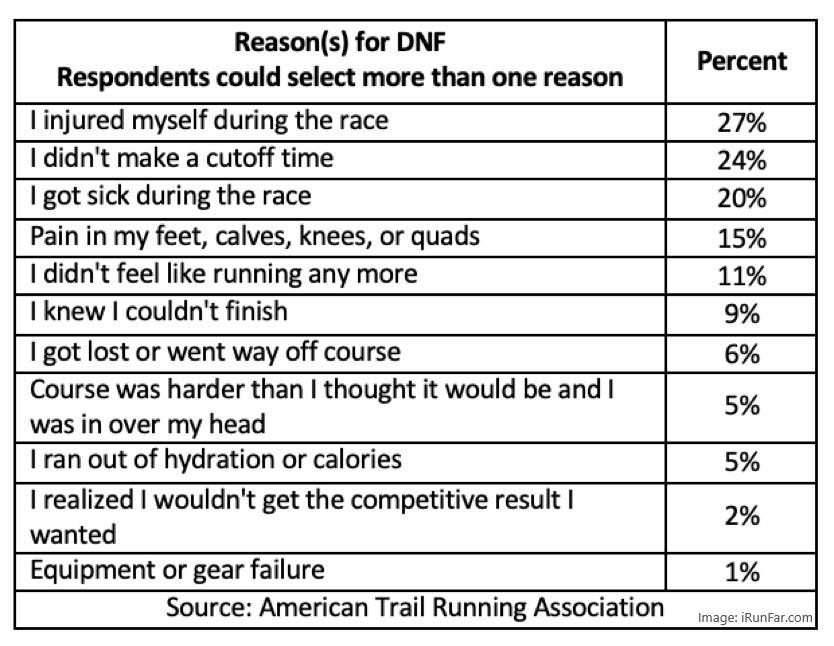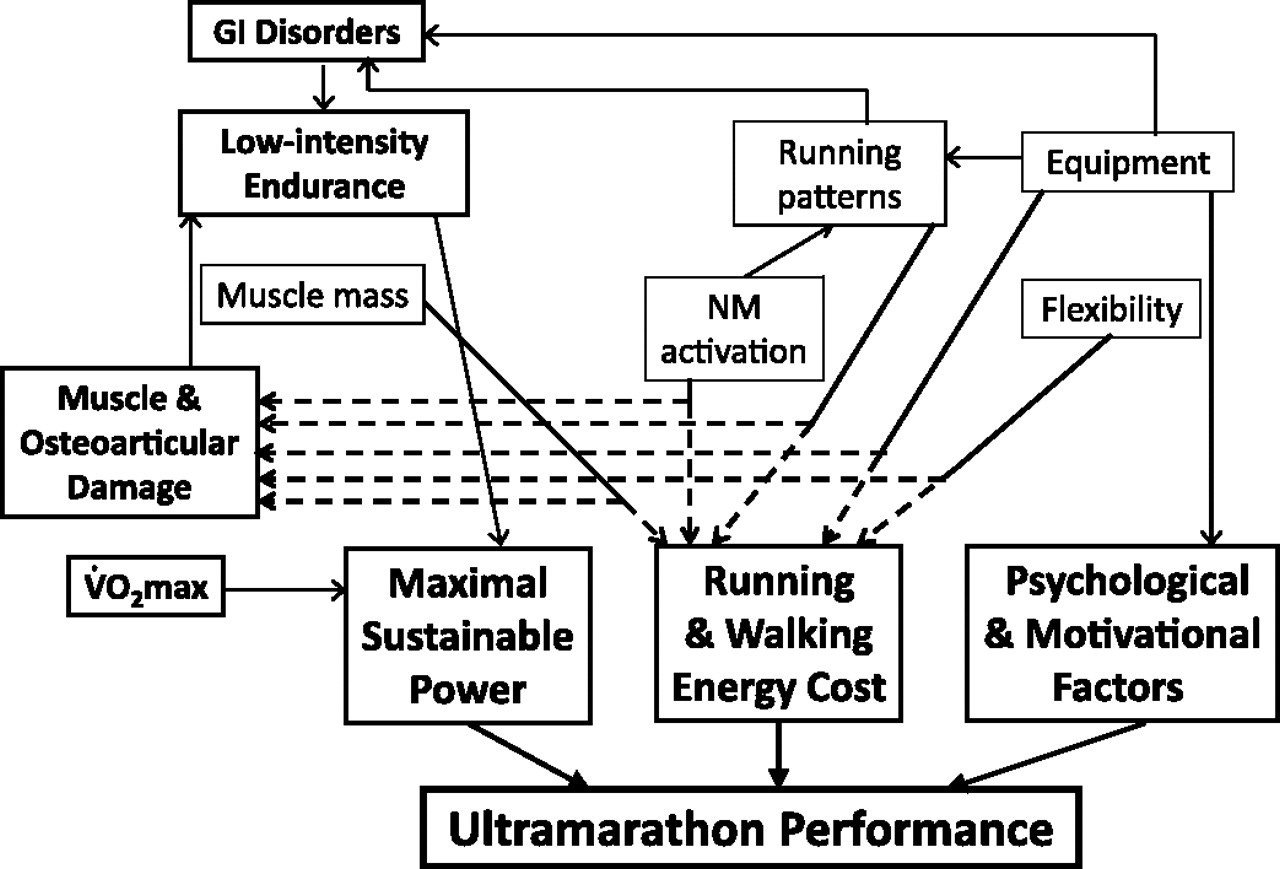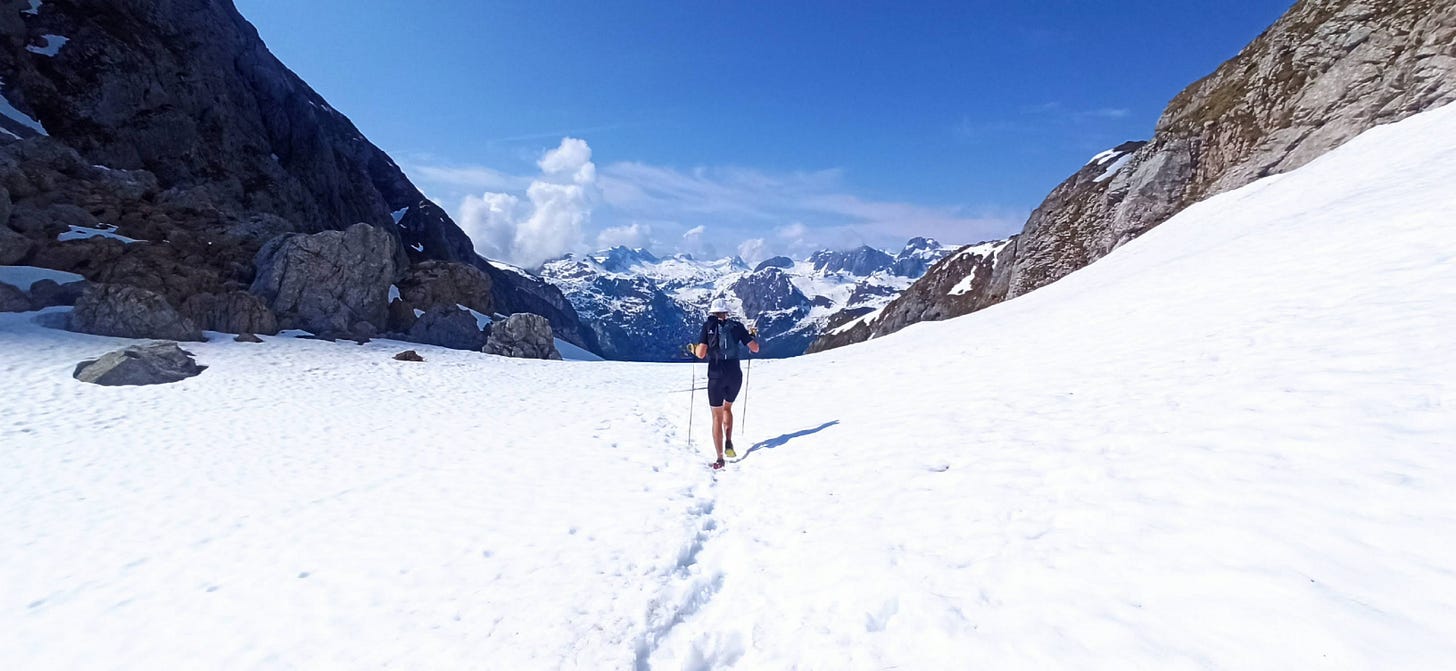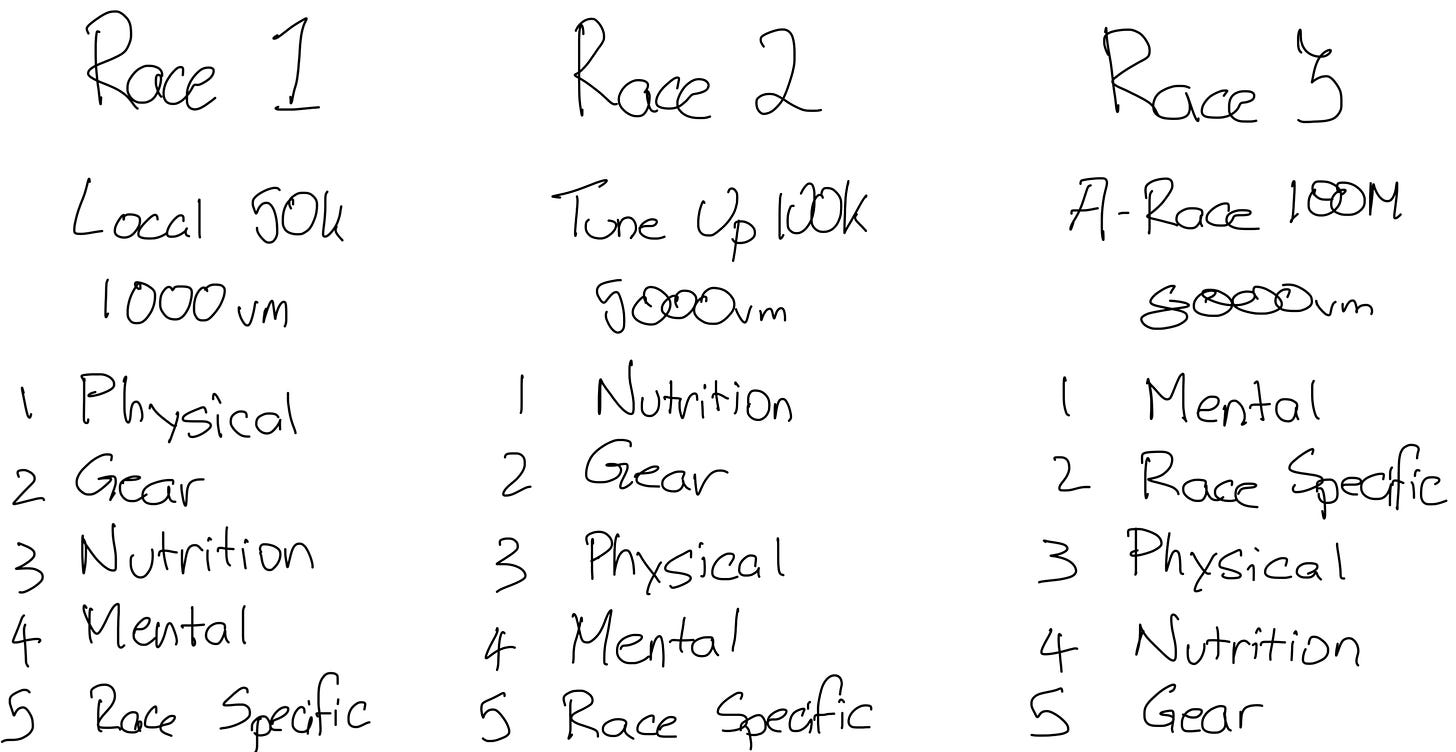The Overlooked Aspects of Ultramarathon Training
When people talk about ultramarathon training, they almost exclusively talk about the physical aspect. However, ultra training is much more than just physical.
You’re browsing UltraSignup and a race catches your eye. The date works, the distance is a challenge, and the elevation is manageable. You sign up, promising yourself that this time you’ll train properly.
You draft a plan: weekly mileage, long runs, and maybe some hill repeats for good measure. It looks solid on paper and you feel good about it.
Race day comes and you line up feeling optimistic because training went perfectly. But then reality hits. The sun is stronger than expected sapping your energy early on. By the halfway point, you have stomach issues and you can’t keep anything down. To make everything worse, after 20 hours of running, your eyes feel heavy and you’re struggling to keep them open. Only a few hours left but you can’t take it anymore. You hobble into the aid station and you sit down, head in your hands. You call the aid station volunteer and, destroyed, you hand over your bib.
Over the next few days the guilt overcomes you. You find yourself browsing UltraSignup again, looking for an opportunity to bounce back, while telling yourself, “Next time, I’ll do better”.
But what does “better” even mean?
I dug into research to understand why people DNF (Did Not Finish) races and found some interesting data from the American Trail Running Association. They surveyed over 1,000 runners about their DNF experiences and the results were surprising.
Understanding DNFs and Ultramarathon Performance

About 50% of DNFs were due to injury or missing cutoff times. While these reasons make sense, I was surprised that they accounted for only half of the DNFs. That means the other half of runners dropped out for reasons other than injury or inadequate physical training.
This struck me because most training plans focus almost entirely on physical preparation: run X times a week, hit Y kilometers for your longest run, taper for Z weeks. But if inadequate physical training only explains 24% of DNFs, then these plans clearly aren’t comprehensive enough to maximise the chance for runners to succeed at their goal event.
This idea that ultramarthon performance depends not only on physical training and performance is also put forward by G. Y. Millet et al. Their research paper shows that although there is a correlation between VO2 max and performance, there are quite a lot of other factors which impact ultramarathon performance such as GI Disorders, equipment along with psychological and motivational factors amongst others.

Looking at these two sources, it is clear to me that training focusing solely on physical training performance for ultramarathons is not enough. This begs the question, what constitutes a holistic ultramarathon training cycle?
Within this post I outline what I deem the be the 5 training aspects required in order to maximise ultramarathon performance along with giving some hints which you can take and incorporate within your training.
Physical Training - The Headline Act
Physical training is the most familiar aspect, and there’s no shortage of information available about it so I’ll keep this section short and share just two practical tips.
First, don’t obsess over the distance of your longest run or the mileage of your peak week. Adding 5 extra kilometers to your longest run might feel like a big deal, but it’s just a drop in the ocean compared to the total mileage you’ll rack up over a 3-4 month training block. Instead, focus on consistency and making sure that you get the desired training effect from each session.
Second, as you get closer to your goal event, try to replicate race day conditions during your long runs. Match the start time, terrain, weather, elevation, and race profile as much as possible. It’s a great way to prepare your body and mind for race day.
Mental Training - The Overlooked Game-Changer
We’ve all heard the clichés about mental training, but how many of us actually do it? While coaches and athletes love to talk about its importance, there’s a lack of practical resources or training plans to guide you through it.
That said, a few mental training plans have started popping up on platforms like Training Peaks - Justin Ross and The Sufferfest offer some. However, as a beginner to mental training, I found these plans too advanced for where I was at the time. If you’re feeling overwhelmed, start small with a few deliberate interventions. Here’s what worked for me:
Find Your Why
Ultra training is hard. It demands time, effort, and grit, and when race day comes, it will test you in ways you never imagined. When you’re tempted to quit, remind yourself why you’re doing this. Why put yourself through it? Why not just walk away? Dig deep and find your real “why” and let it guide your training and racing philosophy. When things get tough, go back to your why and the decision on whether you should quit should come naturally.
If you have already tried finding your why and are struggling, maybe try using the 7 whys approach. I found that the depth is really what helps you really get to the bottom of the “why” question.
Imagery and Problem Solving
If I ask you to visualize your next race, you’ll probably picture a happy runner gliding through scenic trails in perfect weather, crossing the finish line with a smile. That’s great - it gives you something to aim for. But have you imagined what happens when things go wrong? What if you’re 10 hours in, dehydrated due to a leaky bottle, chafing from a new pack, and battling a nagging knee pain? Visualizing these low moments and planning how you’ll handle them is crucial. Reality is rarely as bad as your worst-case scenario, and if you can mentally push through that, you can handle whatever the race throws at you.
Gain Confidence Through Training
We’ve all stood on the start line wondering if we’ve done enough to make it to the finish. The truth is, you’ll face challenges during the race and the only way to power through them is to have a deep toolbox of resources.
I use the demands-resources model to deepen my toolbox. It involves listing all the demands your race will require of you and coming up with deliberate interventions which you will take with you to your event. By training specifically for the demands of your race or event, you’re filling your toolbox with resources that you are able to deploy on race day.
Since I understand the description I gave of this model is a bit vague, I’ll dive deeper into this process in my next post so stay tuned. 😉
Author’s note: I have released this post and you can find it by clicking here.
Nutrition - The Influencer’s Favorite
Gels, bars, powders, ketones, 90g of carbs, optimal carb-to-protein ratios - your favorite influencer has probably hyped at least one of these. But I’m here to suggest something simpler: create a nutrition plan and build towards it in training. Decide what, how much, and how often you’ll eat, and practice it on your long runs. Research has shown that it is indeed possible to train the gut so effort in this direction is definitely valuable.
Sure, you can’t fully predict how you’ll feel after 20 hours without actually running for 20 hours, but that’s why you need backup plans. Personally, I always carry a variety of nutrition options (with aid station food being my last resort). That way, no matter how I’m feeling, I know I’ve got something in my pack that I can stomach.
Gear - Because Function > Fashion
Gear failure might only account for 1% of DNFs, but I think the real number is much higher. Sure, a broken headlamp is an obvious gear issue, but blisters and chafing? Those often stem from using the wrong gear. The good news is that these issues can be tested and mitigated ahead of time.
My advice here is simple: test all your gear thoroughly in training, especially on long runs. Additionally, always have an extra set (or two) of race clothing in your drop bag or with your crew. If something isn’t working, you’ll have a backup ready to go.
Oh, and one golden rule: nothing new on race day! This applies to both nutrition and gear. Resist the temptation to use anything you pick up at the race expo no matter how cool it looks. Cool photos in new gear isn’t worth the risk of a DNF.
Race Specific - The Wild Cards
While the previous aspects apply to most ultras, some race-specific factors aren’t universal but can still make or break your performance. These include extreme weather conditions, altitude (over 3,000m/10,000ft), steep elevation, sleep and unfamiliar terrain just to name a few. Unfortunately, these conditions are often complicated to train for because they’re rather unique.
Some, like heat and sleep, can be managed with specific interventions. Others, like altitude or elevation, may be tougher to replicate. Ideally, you plan a training camp on the race course but that’s not always realistic.
So, get creative. Try to mimic the conditions as closely as possible and build confidence through deliberate practice. Use the imagery technique I mentioned earlier to mentally prepare for tough moments. Reading race reports from past participants can also give you valuable insights.
At the end of the day, trust your training. Sure, there might be one aspect you couldn’t fully prepare for, but you’ve done everything else to set yourself up for success. Believe that your preparation will help you handle whatever the race throws at you.
Prioritising What Matters
I used to prioritize physical training above everything else, but I’ve learned that that’s not the best approach. For example, I always avoided night runs to ensure I was fully recovered for my next workout. Sounds logical, right? But during one race, I realized how uncomfortable I was running in the dark. My headlamp didn’t sit right, every sound made me jumpy, and I spent hours counting down until sunrise totally pulling me out of my flow.
Looking back, I realized even a handful of night runs during training would’ve made a huge difference. This experience, and others like it, inspired me to write this post.
Now, I prioritize the necessary areas where I feel weakest because I know they’ll have the biggest impact on race day. For example, if I’m already in good physical shape, I’ll focus on mental or race-specific interventions since those will result in a better overall performance compared to adding a few extra kilometers to my long run. On the flip side, if I’m running a fast 50k, I’ll focus more on high-intensity training because that’s an area I know I struggle.
Therefore, my suggestion is to shift your focus based on your current fitness, previous training and the demands of your upcoming event. I use the Demands-Resources Model to guide these decisions, and I’ll dive deeper into that in my next post. If you’re curious to learn more, please share with your friends and make sure to subscribe!
Author’s note: I have released the post about the Demands-Resources Model and you can find it by clicking here.
Who am I?
Hi, I’m Niki - a Maltese 🇲🇹 long-distance trail runner now based in Salzburg, Austria 🇦🇹.
Over the years, I’ve had the chance to run in some incredible races around the world, like the 2023 Backyard Ultra Individual World Championships, CCC, and the Mozart 100 by UTMB. Along the way, I’ve learned so much that I think could help others on their trail and ultrarunning journeys. That’s why I decided to start this blog - to share those tips and experiences in one place.
If you enjoy this post, feel free to share it with your friends or subscribe (as a free or paid supporter) to stay updated whenever there’s something new. You can also connect with me on social media, I’d love to hear from you!









Nice article! Well written 👏